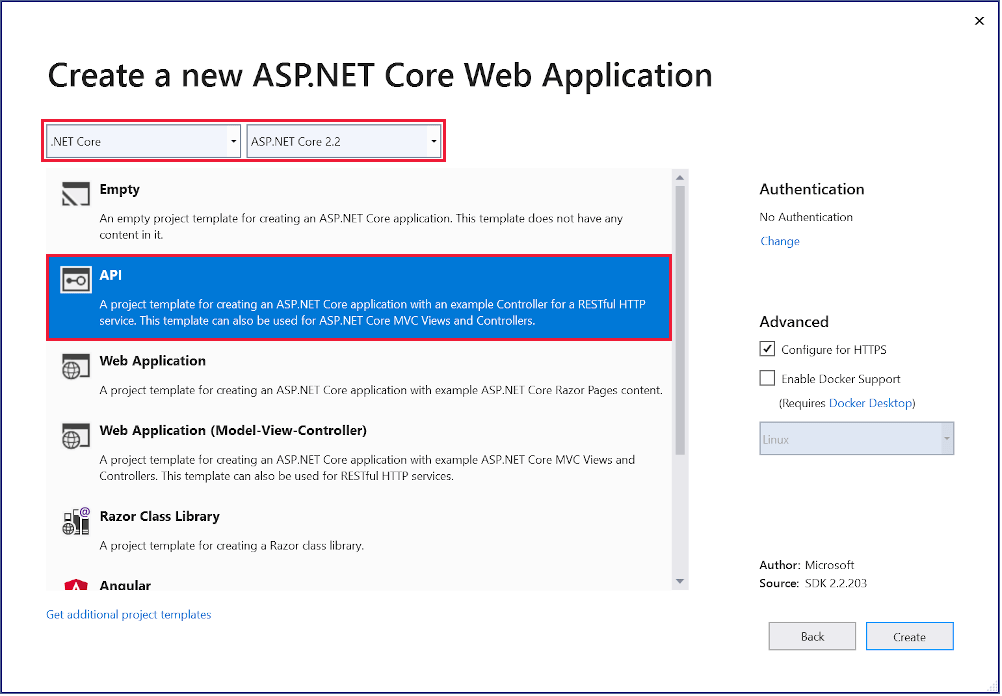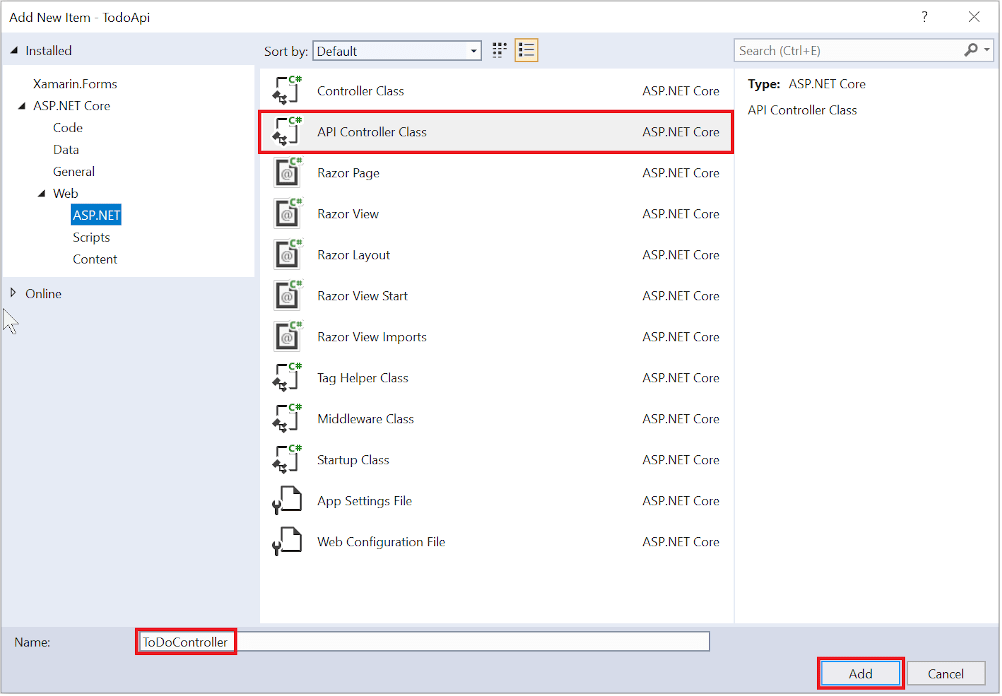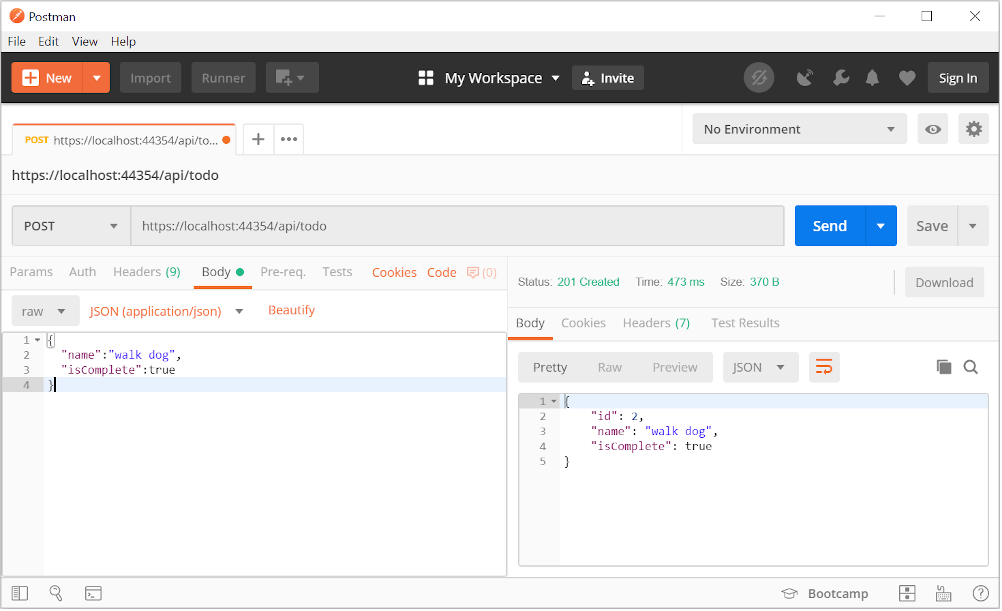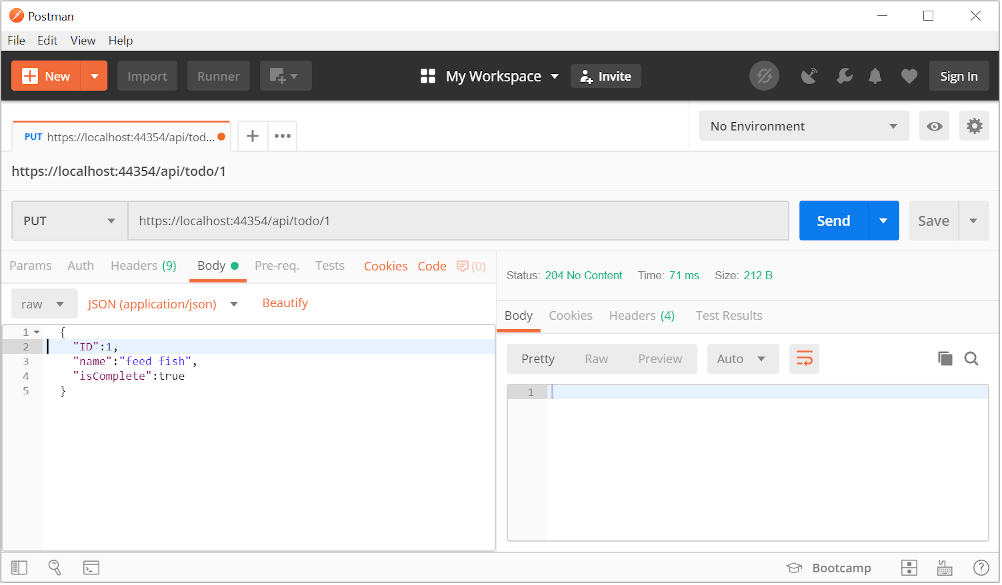In this blog, you learn how to:
- Create a web API project.
- Add a model class and a database context.
- Add a controller.
- Add CRUD methods.
- Configure routing and URL paths.
- Specify return values.
- Call the web API with Postman.
- Call the web API with jQuery.
At the end, you have a web API that can manage "to-do" items stored in a relational database.
Overview
This tutorial creates the following API:
The following diagram shows the design of the app.

Prerequisites
- Visual Studio 2019 with the ASP.NET and web development workload
- .NET Core SDK 2.2 or later
Warning
If you use Visual Studio 2017, see dotnet/sdk issue #3124 for information about .NET Core SDK versions that don't work with Visual Studio.
Create a web project
- From the File menu, select New > Project.
- Select the ASP.NET Core Web Application template and click Next.
- Name the project TodoApi and click Create.
- In the Create a new ASP.NET Core Web Application dialog, confirm that .NET Core and ASP.NET Core 2.2 are selected. Select the API template and click Create. Don't select Enable Docker Support.

Test the API
The project template creates a
values API. Call the Get method from a browser to test the app.
Press Ctrl+F5 to run the app. Visual Studio launches a browser and navigates to
https://localhost:<port>/api/values, where <port> is a randomly chosen port number.
If you get a dialog box that asks if you should trust the IIS Express certificate, select Yes. In the Security Warning dialog that appears next, select Yes.
The following JSON is returned:
JSON
["value1","value2"]
Add a model class
A model is a set of classes that represent the data that the app manages. The model for this app is a single
TodoItem class.- In Solution Explorer, right-click the project. Select Add > New Folder. Name the folder Models.
- Right-click the Models folder and select Add > Class. Name the class TodoItem and select Add.
- Replace the template code with the following code:
C#
namespace TodoApi.Models
{
public class TodoItem
{
public long Id { get; set; }
public string Name { get; set; }
public bool IsComplete { get; set; }
}
}
The
Id property functions as the unique key in a relational database.
Model classes can go anywhere in the project, but the Models folder is used by convention.
Add a database context
The database context is the main class that coordinates Entity Framework functionality for a data model. This class is created by deriving from the
Microsoft.EntityFrameworkCore.DbContext class.- Right-click the Models folder and select Add > Class. Name the class TodoContext and click Add.
- Replace the template code with the following code:
- C#
using Microsoft.EntityFrameworkCore; namespace TodoApi.Models { public class TodoContext : DbContext { public TodoContext(DbContextOptions<TodoContext> options) : base(options) { } public DbSet<TodoItem> TodoItems { get; set; } } }
Register the database context
In ASP.NET Core, services such as the DB context must be registered with the dependency injection (DI) container. The container provides the service to controllers.
Update Startup.cs with the following highlighted code:
C#
// Unused usings removed
using Microsoft.AspNetCore.Builder;
using Microsoft.AspNetCore.Hosting;
using Microsoft.AspNetCore.Mvc;
using Microsoft.EntityFrameworkCore;
using Microsoft.Extensions.Configuration;
using Microsoft.Extensions.DependencyInjection;
using TodoApi.Models;
namespace TodoApi
{
public class Startup
{
public Startup(IConfiguration configuration)
{
Configuration = configuration;
}
public IConfiguration Configuration { get; }
// This method gets called by the runtime. Use this method to add services to the
//container.
public void ConfigureServices(IServiceCollection services)
{
services.AddDbContext<TodoContext>(opt =>
opt.UseInMemoryDatabase("TodoList"));
services.AddMvc().SetCompatibilityVersion(CompatibilityVersion.Version_2_2);
}
// This method gets called by the runtime. Use this method to configure the HTTP
//request pipeline.
public void Configure(IApplicationBuilder app, IHostingEnvironment env)
{
if (env.IsDevelopment())
{
app.UseDeveloperExceptionPage();
}
else
{
// The default HSTS value is 30 days. You may want to change this for
// production scenarios, see https://aka.ms/aspnetcore-hsts.
app.UseHsts();
}
app.UseHttpsRedirection();
app.UseMvc();
}
}
}
The preceding code:
- Removes unused
usingdeclarations. - Adds the database context to the DI container.
- Specifies that the database context will use an in-memory database.
Add a controller
- Right-click the Controllers folder.
- Select Add > New Item.
- In the Add New Item dialog, select the API Controller Class template.
- Name the class TodoController, and select Add.

- Replace the template code with the following code:C#
using Microsoft.AspNetCore.Mvc; using Microsoft.EntityFrameworkCore; using System.Collections.Generic; using System.Linq; using System.Threading.Tasks; using TodoApi.Models; namespace TodoApi.Controllers { [Route("api/[controller]")] [ApiController] public class TodoController : ControllerBase { private readonly TodoContext _context; public TodoController(TodoContext context) { _context = context; if (_context.TodoItems.Count() == 0) { // Create a new TodoItem if collection is empty, // which means you can't delete all TodoItems. _context.TodoItems.Add(new TodoItem { Name = "Item1" }); _context.SaveChanges(); } } } }
The preceding code:
- Defines an API controller class without methods.
- Decorates the class with the [ApiController] attribute. This attribute indicates that the controller responds to web API requests. For information about specific behaviors that the attribute enables, see Create web APIs with ASP.NET Core.
- Uses DI to inject the database context (
TodoContext) into the controller. The database context is used in each of the CRUD methods in the controller. - Adds an item named
Item1to the database if the database is empty. This code is in the constructor, so it runs every time there's a new HTTP request. If you delete all items, the constructor createsItem1again the next time an API method is called. So it may look like the deletion didn't work when it actually did work.
Add Get methods
To provide an API that retrieves to-do items, add the following methods to the
TodoController class:
C#
// GET: api/Todo
[HttpGet]
public async Task<ActionResult<IEnumerable<TodoItem>>> GetTodoItems()
{
return await _context.TodoItems.ToListAsync();
}
// GET: api/Todo/5
[HttpGet("{id}")]
public async Task<ActionResult<TodoItem>> GetTodoItem(long id)
{
var todoItem = await _context.TodoItems.FindAsync(id);
if (todoItem == null)
{
return NotFound();
}
return todoItem;
}
These methods implement two GET endpoints:
GET /api/todoGET /api/todo/{id}
Stop the app if it's still running. Then run it again to include the latest changes.
Test the app by calling the two endpoints from a browser. For example:
https://localhost:<port>/api/todohttps://localhost:<port>/api/todo/1
The following HTTP response is produced by the call to
GetTodoItems:
JSON
[
{
"id": 1,
"name": "Item1",
"isComplete": false
}
]
Routing and URL paths
The
[HttpGet] attribute denotes a method that responds to an HTTP GET request. The URL path for each method is constructed as follows:- Start with the template string in the controller's
Routeattribute:C#namespace TodoApi.Controllers { [Route("api/[controller]")] [ApiController] public class TodoController : ControllerBase { private readonly TodoContext _context; - Replace
[controller]with the name of the controller, which by convention is the controller class name minus the "Controller" suffix. For this sample, the controller class name is TodoController, so the controller name is "todo". ASP.NET Core routing is case insensitive. - If the
[HttpGet]attribute has a route template (for example,[HttpGet("products")]), append that to the path. This sample doesn't use a template. For more information, see Attribute routing with Http[Verb] attributes.
In the following
GetTodoItem method, "{id}" is a placeholder variable for the unique identifier of the to-do item. When GetTodoItem is invoked, the value of "{id}" in the URL is provided to the method in itsid parameter.
C#
// GET: api/Todo/5
[HttpGet("{id}")]
public async Task<ActionResult<TodoItem>> GetTodoItem(long id)
{
var todoItem = await _context.TodoItems.FindAsync(id);
if (todoItem == null)
{
return NotFound();
}
return todoItem;
}
Return values
The return type of the
GetTodoItems and GetTodoItem methods is ActionResult<T> type. ASP.NET Core automatically serializes the object to JSON and writes the JSON into the body of the response message. The response code for this return type is 200, assuming there are no unhandled exceptions. Unhandled exceptions are translated into 5xx errors.ActionResult return types can represent a wide range of HTTP status codes. For example, GetTodoItem can return two different status values:- If no item matches the requested ID, the method returns a 404 NotFound error code.
- Otherwise, the method returns 200 with a JSON response body. Returning
itemresults in an HTTP 200 response.
Test the GetTodoItems method
This tutorial uses Postman to test the web API.
- Install Postman
- Start the web app.
- Start Postman.
- Disable SSL certificate verification
- From File > Settings (General tab), disable SSL certificate verification.
Warning
Re-enable SSL certificate verification after testing the controller.
- Create a new request.
- Set the HTTP method to GET.
- Set the request URL to
https://localhost:<port>/api/todo. For example,https://localhost:5001/api/todo.
- Set Two pane view in Postman.
- Select Send.

Add a Create method
Add the following
PostTodoItem method inside of Controllers/TodoController.cs:
C#
// POST: api/Todo
[HttpPost]
public async Task<ActionResult<TodoItem>> PostTodoItem(TodoItem item)
{
_context.TodoItems.Add(item);
await _context.SaveChangesAsync();
return CreatedAtAction(nameof(GetTodoItem), new { id = item.Id }, item);
}
The preceding code is an HTTP POST method, as indicated by the [HttpPost] attribute. The method gets the value of the to-do item from the body of the HTTP request.
The
CreatedAtAction method:- Returns an HTTP 201 status code, if successful. HTTP 201 is the standard response for an HTTP POST method that creates a new resource on the server.
- Adds a
Locationheader to the response. TheLocationheader specifies the URI of the newly created to-do item. For more information, see 10.2.2 201 Created. - References the
GetTodoItemaction to create theLocationheader's URI. The C#nameofkeyword is used to avoid hard-coding the action name in theCreatedAtActioncall.C#// GET: api/Todo/5 [HttpGet("{id}")] public async Task<ActionResult<TodoItem>> GetTodoItem(long id) { var todoItem = await _context.TodoItems.FindAsync(id); if (todoItem == null) { return NotFound(); } return todoItem; }
Test the PostTodoItem method
- Build the project.
- In Postman, set the HTTP method to
POST. - Select the Body tab.
- Select the raw radio button.
- Set the type to JSON (application/json).
- In the request body enter JSON for a to-do item:JSON
{ "name":"walk dog", "isComplete":true } - Select Send.
 If you get a 405 Method Not Allowed error, it's probably the result of not compiling the project after adding the
If you get a 405 Method Not Allowed error, it's probably the result of not compiling the project after adding thePostTodoItemmethod.
Test the location header URI
- Select the Headers tab in the Response pane.
- Copy the Location header value:

- Set the method to GET.
- Paste the URI (for example,
https://localhost:5001/api/Todo/2) - Select Send.
Add a PutTodoItem method
Add the following
PutTodoItem method:
C#
// PUT: api/Todo/5
[HttpPut("{id}")]
public async Task<IActionResult> PutTodoItem(long id, TodoItem item)
{
if (id != item.Id)
{
return BadRequest();
}
_context.Entry(item).State = EntityState.Modified;
await _context.SaveChangesAsync();
return NoContent();
}
PutTodoItem is similar to PostTodoItem, except it uses HTTP PUT. The response is 204 (No Content). According to the HTTP specification, a PUT request requires the client to send the entire updated entity, not just the changes. To support partial updates, use HTTP PATCH.
If you get an error calling
PutTodoItem, call GET to ensure there's an item in the database.Test the PutTodoItem method
This sample uses an in-memory database that must be initialed each time the app is started. There must be an item in the database before you make a PUT call. Call GET to insure there's an item in the database before making a PUT call.
Update the to-do item that has id = 1 and set its name to "feed fish":
JSON
{
"ID":1,
"name":"feed fish",
"isComplete":true
}
The following image shows the Postman update:

Add a DeleteTodoItem method
Add the following
DeleteTodoItem method:
C#
// DELETE: api/Todo/5
[HttpDelete("{id}")]
public async Task<IActionResult> DeleteTodoItem(long id)
{
var todoItem = await _context.TodoItems.FindAsync(id);
if (todoItem == null)
{
return NotFound();
}
_context.TodoItems.Remove(todoItem);
await _context.SaveChangesAsync();
return NoContent();
}
The
DeleteTodoItem response is 204 (No Content).Test the DeleteTodoItem method
Use Postman to delete a to-do item:
- Set the method to
DELETE. - Set the URI of the object to delete, for example
https://localhost:5001/api/todo/1 - Select Send
The sample app allows you to delete all the items. However, when the last item is deleted, a new one is created by the model class constructor the next time the API is called.
Call the API with jQuery
In this section, an HTML page is added that uses jQuery to call the web api. jQuery initiates the request and updates the page with the details from the API's response.
Configure the app to serve static files and enable default file mapping by updating Startup.cs with the following highlighted code:
C#
public void Configure(IApplicationBuilder app, IHostingEnvironment env)
{
if (env.IsDevelopment())
{
app.UseDeveloperExceptionPage();
}
else
{
// The default HSTS value is 30 days. You may want to change this for
// production scenarios, see https://aka.ms/aspnetcore-hsts.
app.UseHsts();
}
app.UseDefaultFiles();
app.UseStaticFiles();
app.UseHttpsRedirection();
app.UseMvc();
}
Create a wwwroot folder in the project directory.
Add an HTML file named index.html to the wwwroot directory. Replace its contents with the following markup:
HTML
<!DOCTYPE html>
<html>
<head>
<meta charset="UTF-8">
<title>To-do CRUD</title>
<style>
input[type='submit'], button, [aria-label] {
cursor: pointer;
}
#spoiler {
display: none;
}
table {
font-family: Arial, sans-serif;
border: 1px solid;
border-collapse: collapse;
}
th {
background-color: #0066CC;
color: white;
}
td {
border: 1px solid;
padding: 5px;
}
</style>
</head>
<body>
<h1>To-do CRUD</h1>
<h3>Add</h3>
<form action="javascript:void(0);" method="POST" onsubmit="addItem()">
<input type="text" id="add-name" placeholder="New to-do">
<input type="submit" value="Add">
</form>
<div id="spoiler">
<h3>Edit</h3>
<form class="my-form">
<input type="hidden" id="edit-id">
<input type="checkbox" id="edit-isComplete">
<input type="text" id="edit-name">
<input type="submit" value="Save">
<a onclick="closeInput()" aria-label="Close">✖</a>
</form>
</div>
<p id="counter"></p>
<table>
<tr>
<th>Is Complete</th>
<th>Name</th>
<th></th>
<th></th>
</tr>
<tbody id="todos"></tbody>
</table>
<script src="https://code.jquery.com/jquery-3.3.1.min.js"
integrity="sha256-FgpCb/KJQlLNfOu91ta32o/NMZxltwRo8QtmkMRdAu8="
crossorigin="anonymous"></script>
<script src="site.js"></script>
</body>
</html>
Add a JavaScript file named site.js to the wwwroot directory. Replace its contents with the following code:
JavaScript
const uri = "api/todo";
let todos = null;
function getCount(data) {
const el = $("#counter");
let name = "to-do";
if (data) {
if (data > 1) {
name = "to-dos";
}
el.text(data + " " + name);
} else {
el.text("No " + name);
}
}
$(document).ready(function() {
getData();
});
function getData() {
$.ajax({
type: "GET",
url: uri,
cache: false,
success: function(data) {
const tBody = $("#todos");
$(tBody).empty();
getCount(data.length);
$.each(data, function(key, item) {
const tr = $("<tr></tr>")
.append(
$("<td></td>").append(
$("<input/>", {
type: "checkbox",
disabled: true,
checked: item.isComplete
})
)
)
.append($("<td></td>").text(item.name))
.append(
$("<td></td>").append(
$("<button>Edit</button>").on("click", function() {
editItem(item.id);
})
)
)
.append(
$("<td></td>").append(
$("<button>Delete</button>").on("click", function() {
deleteItem(item.id);
})
)
);
tr.appendTo(tBody);
});
todos = data;
}
});
}
function addItem() {
const item = {
name: $("#add-name").val(),
isComplete: false
};
$.ajax({
type: "POST",
accepts: "application/json",
url: uri,
contentType: "application/json",
data: JSON.stringify(item),
error: function(jqXHR, textStatus, errorThrown) {
alert("Something went wrong!");
},
success: function(result) {
getData();
$("#add-name").val("");
}
});
}
function deleteItem(id) {
$.ajax({
url: uri + "/" + id,
type: "DELETE",
success: function(result) {
getData();
}
});
}
function editItem(id) {
$.each(todos, function(key, item) {
if (item.id === id) {
$("#edit-name").val(item.name);
$("#edit-id").val(item.id);
$("#edit-isComplete")[0].checked = item.isComplete;
}
});
$("#spoiler").css({ display: "block" });
}
$(".my-form").on("submit", function() {
const item = {
name: $("#edit-name").val(),
isComplete: $("#edit-isComplete").is(":checked"),
id: $("#edit-id").val()
};
$.ajax({
url: uri + "/" + $("#edit-id").val(),
type: "PUT",
accepts: "application/json",
contentType: "application/json",
data: JSON.stringify(item),
success: function(result) {
getData();
}
});
closeInput();
return false;
});
function closeInput() {
$("#spoiler").css({ display: "none" });
}
A change to the ASP.NET Core project's launch settings may be required to test the HTML page locally:
- Open Properties\launchSettings.json.
- Remove the
launchUrlproperty to force the app to open at index.html—the project's default file.
There are several ways to get jQuery. In the preceding snippet, the library is loaded from a CDN.
This sample calls all of the CRUD methods of the API. Following are explanations of the calls to the API.
Get a list of to-do items
The jQuery ajax function sends a
GET request to the API, which returns JSON representing an array of to-do items. The success callback function is invoked if the request succeeds. In the callback, the DOM is updated with the to-do information.
JavaScript
$(document).ready(function() {
getData();
});
function getData() {
$.ajax({
type: "GET",
url: uri,
cache: false,
success: function(data) {
const tBody = $("#todos");
$(tBody).empty();
getCount(data.length);
$.each(data, function(key, item) {
const tr = $("<tr></tr>")
.append(
$("<td></td>").append(
$("<input/>", {
type: "checkbox",
disabled: true,
checked: item.isComplete
})
)
)
.append($("<td></td>").text(item.name))
.append(
$("<td></td>").append(
$("<button>Edit</button>").on("click", function() {
editItem(item.id);
})
)
)
.append(
$("<td></td>").append(
$("<button>Delete</button>").on("click", function() {
deleteItem(item.id);
})
)
);
tr.appendTo(tBody);
});
todos = data;
}
});
}
Add a to-do item
The ajax function sends a
POST request with the to-do item in the request body. The accepts and contentType options are set to application/json to specify the media type being received and sent. The to-do item is converted to JSON by using JSON.stringify. When the API returns a successful status code, the getData function is invoked to update the HTML table.
JavaScript
function addItem() {
const item = {
name: $("#add-name").val(),
isComplete: false
};
$.ajax({
type: "POST",
accepts: "application/json",
url: uri,
contentType: "application/json",
data: JSON.stringify(item),
error: function(jqXHR, textStatus, errorThrown) {
alert("Something went wrong!");
},
success: function(result) {
getData();
$("#add-name").val("");
}
});
}
Update a to-do item
Updating a to-do item is similar to adding one. The
url changes to add the unique identifier of the item, and the type is PUT.
JavaScript
$.ajax({
url: uri + "/" + $("#edit-id").val(),
type: "PUT",
accepts: "application/json",
contentType: "application/json",
data: JSON.stringify(item),
success: function(result) {
getData();
}
});
Delete a to-do item
Deleting a to-do item is accomplished by setting the
type on the AJAX call to DELETE and specifying the item's unique identifier in the URL.
JavaScript
$.ajax({
url: uri + "/" + id,
type: "DELETE",
success: function(result) {
getData();
}
});
No comments:
Post a Comment